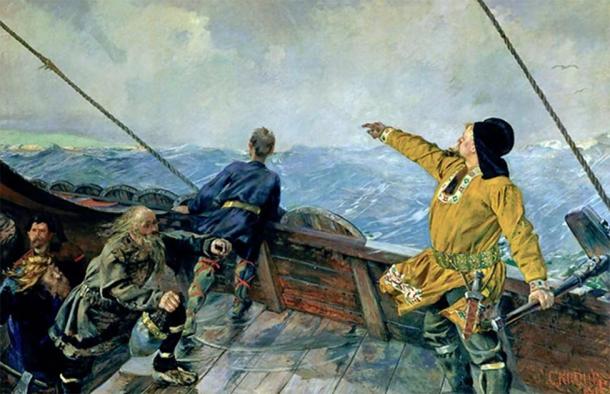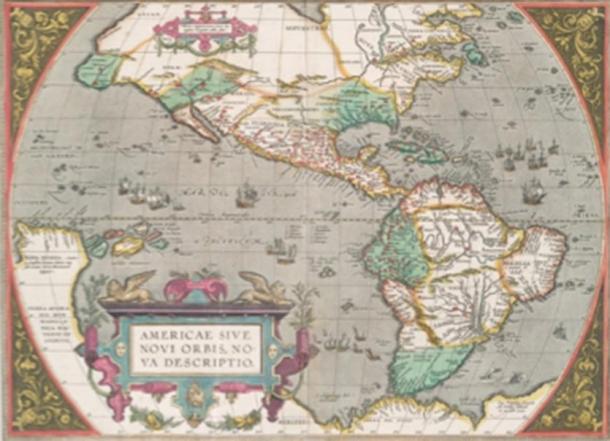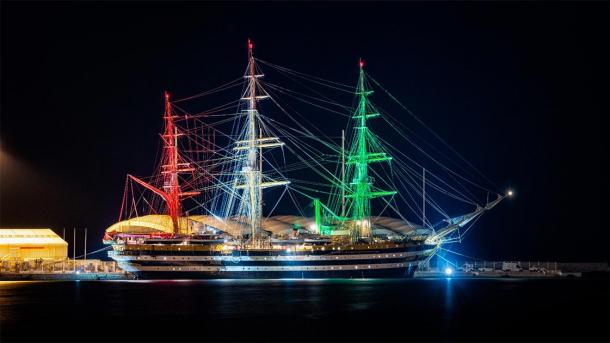
Amerigo Vespucci: The Forgotten Explorer Who Named America
The age of discovery is certainly one of the most dramatic periods of European history - a period of revolutionary voyages and contacts with the fascinating and mysterious New World.
Many prominent navigators, explorers and captains were fascinated by the possibilities of a world outside the known boundaries of Europe, a world far across the expanses of the ocean. In this New World there were many opportunities, including those of trade, gold, conquest, and riches.
Today we know this New World as America, but do you know where its name came from? The famous Florentine navigator, the man who is often overshadowed by Columbus, is the one who further confirmed Columbus’ ‘discoveries’ and gave his name to the continent. He is Amerigo Vespucci, and here is his story.

Portrait of Amerigo Vespucci with a map. Possibly painted by Cristofano dell'Altissimo. Source: Public domain
The Early Life of Amerigo Vespucci
Before we begin the story of this famous navigator, we need to talk about the so-called New World. The American continent was not first encountered by Columbus, nor Vespucci, as was believed at the time. History has known many sailors through the ages, and many seafaring civilizations. And once you set out on the ocean, you’re bound to discover America sooner or later.
Some of the first seafarers to reach America were the Vikings. Under the leadership of an Icelandic Viking, Leif Erikson, the Norsemen successfully traversed the ocean and reached the coast of North America. This occurred around 1000 AD, almost five centuries before Columbus. In 1492, the Italian explorer Christopher Columbus was the first European that reached the islands of the Caribbean. But mistakenly, he thought he had at last reached the outskirts of Asia, and thus named these islands “the Indies”. It was his countryman and contemporary that would prove him wrong - Amerigo Vespucci.

A depiction of Leif Eriksson discovering the Americas, painted in 1893. (Christian Krohg / Public domain)
Amerigo was born in 1454, into the prominent Vespucci family, in Florence, Italy. The Vespuccis were a respected family who were Florence natives for over two centuries. Most people connected their name to Italian nobility. But that does not mean that they were a rich aristocratic family. Instead, they were relatively poor, and often engaged in trading and other mercantile ventures.
From a young age, Amerigo was educated by his uncle, a Dominican friar by the name of Giorgio Antonio Vespucci. Even as a boy, Amerigo studied the arts, literature, mathematics, and above all - geography. Later in his life, he was sent to the University of Pisa, where he received a higher education. During Amerigo’s youth and later life, Florence - thanks to the House of Medici - was an epicenter of art, literature, and the beginnings of the Renaissance.
Eventually, Amerigo was acquainted with the members of this prominent Medici family, and subsequently embraced a mercantile life. As a trader, he acquired a position in the well-known trading house of Lorenzo de’ Medici. Due to his birth and his ties, Amerigo obtained the position with the Medicis, as the latter sought capable men. Trading in Florence required a skill in diplomacy, speech, and a good grasp of commercial business. Amerigo had all of these skills well mastered.

Portrait of Lorenzo de’ Medici from the 16 th century. (Agnolo Bronzino / Public domain)
After receiving the position, he soon travelled to Barcelona in Spain, as required by his work. The Iberian Peninsula of that age was a lucrative place for business and adventure, especially because of the Portuguese and Spanish explorers and navigators.
Vespucci became engaged in a lot of business in Spain, particularly Seville, where he conducted the outfitting of Spanish vessels that were used in discovery voyages. Around this time, the Crown of Castile fell out with Christopher Columbus and broke the monopoly deal they had with him. Subsequently, they began licensing and seeking out other prominent navigators to sail to the West Indies.
When the Ocean Beckons: His Earliest Voyages
He became increasingly interested in these exploratory voyages himself. It is thought at some point, he came into contact and sailed with Christopher Columbus. But eventually, Vespucci wanted to go on his own explorations. He had the necessary prerequisites - a good education, fantastic connections in Italy and Spain, a sailing background, and a great deal of skills in trading, business, geography, and astronomy.
He sailed with Alonso de Hojeda on one of his journeys, accompanying him as an astronomer and a merchant. Vespucci was no ordinary explorer, and that was clear. As a learned man, he pursued astronomy, studying the stars as they sailed, hoping to find the southern celestial pole. Many believe that once he started these sailing voyages in earnest, Vespucci truly embraced this calling and fully transformed from a businessman into a scholar and a navigator.
Once back in Spain, Amerigo Vespucci declined (for unknown reasons) the offer of three ships and supplies to sail once again for the Spanish government. But seeing the success of the Portuguese sailor Vasco da Gama, who successfully sailed around the African continent, Vespucci realized that he too needed to sail for the Portuguese in order to make headlines. This was also because the Portuguese boasted much quicker and sturdier ships than the Spanish ones.

Portrait of Vasco de Gama. (António Manuel da Fonseca / Public domain)
Therefore, Vespucci acquired the command of three Portuguese ships, which he had complete control over. It was at this time that he made his second voyage, which is the first one that scholars have confirmed as authentic. He set out from Portugal in May 1501, and he made it his mission to discover the so-called Strait of Catigara, a passage that Ptolemy claimed, in his writings, would lead to Asia.
Finding a Whole New World
Instead, this voyage actually took Vespucci along the coast of South America, but it is also the one that would eventually make him a famous man. When he realized that he was nowhere near Asia, he knew he had discovered a wholly new continent that lay between Asia and Europe. Since he had a keen knowledge of geography and was aware of its imperfections and inconsistencies, his sailing along the coast and careful observations allowed him to deduce that it was indeed a continent that had been unknown to Europe.
- Did a Welsh Prince Reach the New World Before Columbus?
- Years Before Columbus: Leif Erikson, His Life and His Voyage of Adventure to the New World
- Trailing the Mayflower - The Iconic Ship of a Pilgrim Voyage to the New World

Ancient map of the Americas from 1606. (Abraham Ortelius / Public domain)
He hastened to write to Lorenzo Medici from what is today Cape Verde. He described in detail the inhabitants of the place he sailed to, the flora and fauna, and the land itself. It is from this letter, we can understand that Vespucci was truly a learned man and well ahead of his time.
In the letter to Medici, he said that he had found a new continent, and gave remarkable claims for his certainty. He spoke of the number of people he had seen, and he explained that their variety signified the enormity of the land, as well as the sheer size of the coastline and the size of the rivers.
Four Voyages and Forged Letters
Amerigo Vespucci made a total of four voyages to the New World, even though scholars today are uncertain of two of these voyages. Most of the accounts of his travels are found in several letters that Vespucci wrote, which detail his explorations.
The first letter claimed that the voyage begun in May 1497 and ended in October 1498. But from historical accounts, we have learnt that at this time, Amerigo was working as a ship outfitter in Seville, and his first sailing voyage with Hojeda begun in May of 1499. Therefore, many scholars believe that this letter is in fact a forgery created in the years after Vespucci’s death, in order to give an earlier date for his explorations.
Another seemingly fake letter attributed to Vespucci is the so-called Mundus Novus letter. It was presented after the death of Lorenzo Medici and is full of inaccuracies and false claims. The same goes for another fake letter called the Four Voyages, which was supposedly written by Vespucci to Piero Soderini, the chief magistrate of Florence. It is believed that Soderini wrote these letters out of jealousy for Lorenzo di Medici, who had received all of Vespucci’s attention and correspondence. The contents of this letter seemingly follow the pattern of Columbus’ voyages and are today the source of most false beliefs connected to Vespucci and his voyages.

Posthumous portrait of Christopher Columbus, 1519. There are no known authentic portraits of Columbus. (Sebastiano del Piombo / Public domain)
A Navigator That Sailed No More
After his revolutionary explorations of the Americas, and his understanding of it as a new continent, Vespucci returned to Portugal and remained there until 1504. After that he returned to Seville in Spain. He had extensive plans to make further explorations, but these were cut short when the Spanish King Ferdinand proclaimed Vespucci as the Pilot Major of Spain in 1508. This position required him to teach the pilots (navigators) of the Spanish fleet skills of navigation, astronomy and cosmography, which he had mastered and utilized during his career.
This put him into a very important position, where he ultimately presided over the Spanish fleet and had control over all its voyages, as well as all the trade between Spain and the colonies in the New World. Sadly, he didn’t hold the post for too long, nor would he ever sail again as he wished. Amerigo Vespucci died of malaria on 22nd of February 1512. He was married but had no children.
A Heritage to Last Eternally
Vespucci left behind an eternal legacy. He truly was a man of “firsts”, a pioneer of trans-oceanic exploration and long voyages. He inspired and trained a whole generation of future navigators, many of whom continued his legacy and repeatedly sought a passage to Asia, by sailing around the tip of South America.

The Amerigo Vespucci, an Italian Navy training ship, which was dedicated to the famous explorer and is still being used today. (Stefano Garau / Adobe stock)
Amerigo’s achievements changed the fate of maritime exploration. First of all, Vespucci was the first European man to sight and reach the shores of Brazil, and to explore its coastline. During his voyages, he explored around 6,000 miles (~9,700 kilometers) of coastline - a feat that hasn’t been accomplished by any other man to date. He was also the first European man to step onto the shores of Colombia, Argentina, and Uruguay, and the first to discover the Amazon, Plata, and Pavia rivers.
Additionally, he was the first to discover the existence of the equatorial current, and to utilize the lunar cycle in order to accurately determine a precise longitude. But of course, his most important achievement was his realization that the “outskirts of Asia,” which his contemporary Columbus discovered, were nowhere near Asia at all, and that they were in fact a new continent. And this New World was named America, the female form of Amerigo’s name in Latin. A heritage to last eternally.
It is certain that Vespucci had an advanced understanding of the world around him, and that he was born in the right age for exploration. He studied the accounts of Marco Polo and Ptolemy, and this helped him to quickly understand that the inhabitants and the landscapes of South America were not Asian in any way whatsoever. He managed to sail extraordinary lengths, and due to this feat, he realized that such a diversity of native tribes, the enormity of coastline, and a mild, warm, and tropical climate, were all telltale signs of a new continent. This realization was one of the most important discoveries in European history.

A statue of Amerigo Vespucci to recognize his achievements and life, Uffizi Museum, Florence. (NICOLAS LARENTO / Adobe stock)
Alas, Amerigo Vespucci is often in the shadow of Christopher Columbus, who admittedly ‘discovered’ the American continent, but without realizing it as such. Furthermore, the account of Vespucci’s life is often marred with the debates regarding his voyages and the false letters, none of which were created by Vespucci himself. In the end, many agree that Amerigo Vespucci made three journeys to the New World, and all know that he truly revolutionized the world of sailing and navigation. However, all of his deeds and explorations are often forgotten, as the ages that came after him, seldom brought any good from the fabled New World.
Top image: Native Americans see the arrival of an explorer’s ship. Credit: ginettigino / Adobe Stock
References
Canaday, J. 2010. The Life of Amerigo Vespucci. Millersville University.
Hoogenboom, L. 2006. Amerigo Vespucci - A Primary Source Biography. Rosen Publishing Group.
Ray, K. 2004. Amerigo Vespucci: Italian Explorer of the Americas. Rosen Publishing Group.
















Comments
Love the story and the first photo, however Natives we’re riding horses when they first saw ships, horses came later.
and what of the idea that America was named after Richard de Americ who funded American exploration from Bristol?